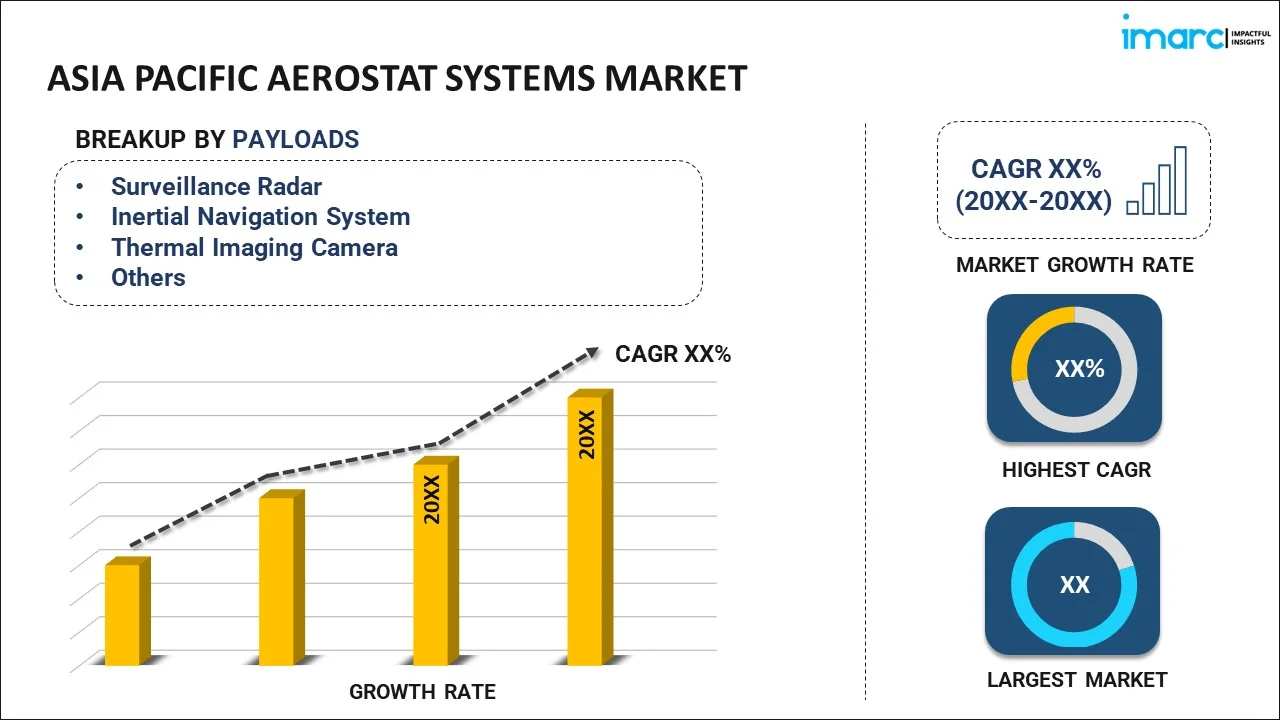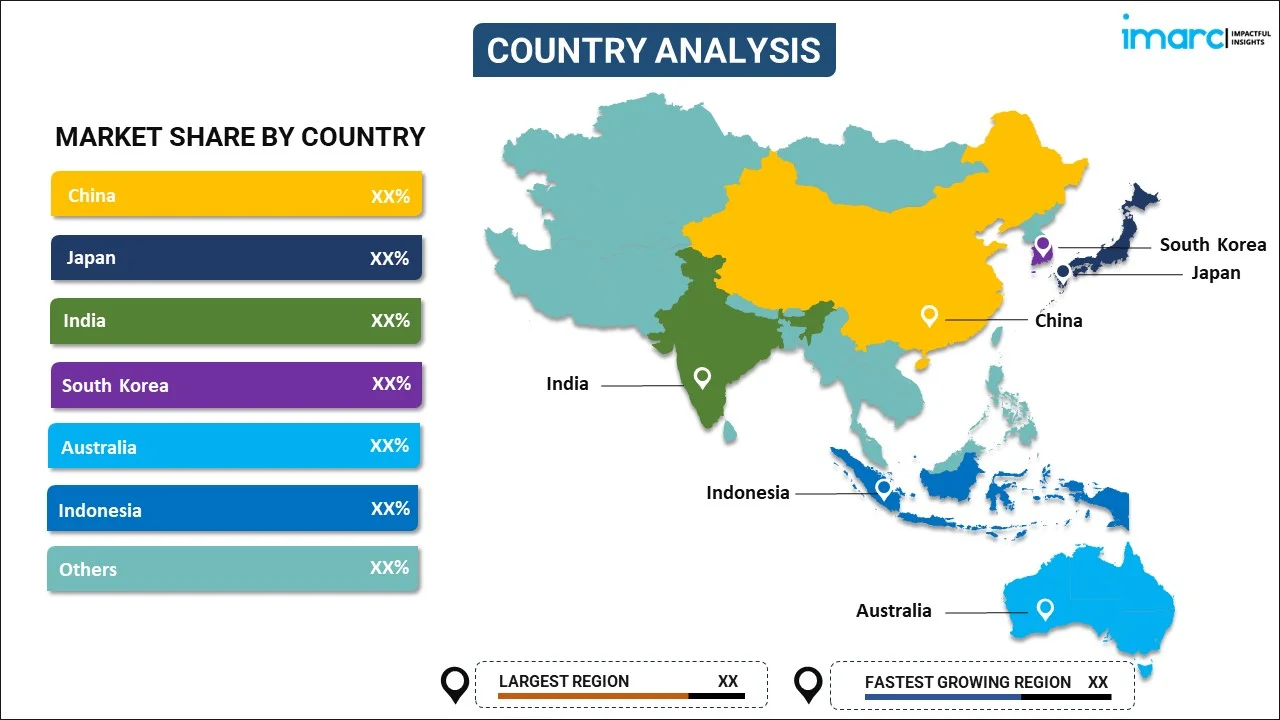
Asia Pacific Aerostat Systems Market Report by Payload (Surveillance Radar, Inertial Navigation System, Thermal Imaging Camera, Electro-Optical Sensor, Electronic Intelligence, Communication Intelligence), Sub-System (Aerostat, Ground Control Station (GCS), Payload), Product Type (Balloon, Airship, Hybrid), Propulsion System (Powered Aerostats, Unpowered Aerostats), Class (Compact-Sized Aerostats, Mid-Sized Aerostats, Large-Sized Aerostats), and Country 2025-2033
Market Overview:
The Asia Pacific aerostat systems market size reached USD 2,803.9 Million in 2024. Looking forward, IMARC Group expects the market to reach USD 7,274.6 Million by 2033, exhibiting a growth rate (CAGR) of 10.62% during 2025-2033.
|
Report Attribute
|
Key Statistics
|
|---|---|
|
Base Year
|
2024
|
|
Forecast Years
|
2025-2033
|
|
Historical Years
|
2019-2024
|
|
Market Size in 2024
|
USD 2,803.9 Million |
|
Market Forecast in 2033
|
USD 7,274.6 Million |
| Market Growth Rate (2025-2033) | 10.62% |
An aerostat system is a low-level airborne craft widely used to elevate light payloads. It is also used as a tactical airborne platform for cameras and communication equipment, scientific equipment, and radar systems. Consequently, aerostat systems are gaining traction in the Asia Pacific region.
The increasing terrorist activities and territorial tension between different countries in the Asia Pacific region are resulting in the rising need for high surveillance units and the growing intelligence among countries. For instance, efficient and robust supervision activities are taking place across the India-Pakistan border and India-China border along the Himalayas. This is positively influencing the aerostat systems market in the region. Moreover, various countries are focusing on adopting technologically advanced aerostat systems to monitor cross-border movements and reinforce surveillance. However, the sudden rise in the coronavirus disease (COVID-19) patients has resulted in complete lockdowns being enforced by the governing agencies of numerous countries in the region. It has negatively affected the market on account of the temporary closures of several manufacturing units and the disruption of the supply chain. The market will experience growth once lockdown restrictions are minimized.
Key Market Segmentation:
IMARC Group provides an analysis of the key trends in each segment of the Asia Pacific aerostat systems market report, along with forecasts at the regional and country levels from 2025-2033. Our report has categorized the market based on payload, sub-system, product type, propulsion system and class.
Breakup by Payload:

- Surveillance Radar
- Inertial Navigation System
- Thermal Imaging Camera
- Electro-Optical Sensor
- Electronic Intelligence
- Communication Intelligence
Breakup by Sub-System:
- Aerostat
- Ground Control Station (GCS)
- Payload
Breakup by Product Type:
- Balloon
- Airship
- Hybrid
Breakup by Propulsion System:
- Powered Aerostats
- Unpowered Aerostats
Breakup by Class:
- Compact-Sized Aerostats
- Mid-Sized Aerostats
- Large-Sized Aerostats
Breakup by Country:

- China
- Japan
- India
- South Korea
- Australia
- Indonesia
- Others
Competitive Landscape:
The competitive landscape of the industry has also been examined along with the profiles of the key players.
Report Coverage:
| Report Features | Details |
|---|---|
| Base Year of the Analysis | 2024 |
| Historical Period | 2019-2024 |
| Forecast Period | 2025-2033 |
| Units | Million USD |
| Segment Coverage | Payload, Sub-System, Product Type, Propulsion System, Class, Country |
| Countries Covered | China, Japan, India, South Korea, Australia, Indonesia, Others |
| Customization Scope | 10% Free Customization |
| Post-Sale Analyst Support | 10-12 Weeks |
| Delivery Format | PDF and Excel through Email (We can also provide the editable version of the report in PPT/Word format on special request) |
Key Questions Answered in This Report:
- How has the Asia Pacific aerostat systems market performed so far and how will it perform in the coming years?
- What has been the impact of COVID-19 on the Asia Pacific aerostat systems market?
- What are the key regional markets?
- What is the breakup of the market based on the payload?
- What is the breakup of the market based on the sub-system?
- What is the breakup of the market based on the product type?
- What is the breakup of the market based on the propulsion system?
- What is the breakup of the market based on the class?
- What are the various stages in the value chain of the industry?
- What are the key driving factors and challenges in the industry?
- What is the structure of the Asia Pacific aerostat systems market and who are the key players?
- What is the degree of competition in the industry?
Need more help?
- Speak to our experienced analysts for insights on the current market scenarios.
- Include additional segments and countries to customize the report as per your requirement.
- Gain an unparalleled competitive advantage in your domain by understanding how to utilize the report and positively impacting your operations and revenue.
- For further assistance, please connect with our analysts.
 Inquire Before Buying
Inquire Before Buying
 Speak to an Analyst
Speak to an Analyst
 Request Brochure
Request Brochure
 Request Customization
Request Customization




.webp)




.webp)












